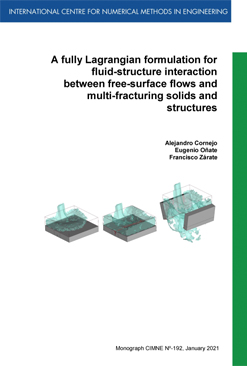A fully Lagrangian formulation for fluid-structure interaction between free-surface flows and multi-fracturing solids and structures
FREE!
Editorial: CIMNE
Year of publication: 2021
Pages: 398
Editorial: CIMNE
Year of publication: 2021
Pages: 398
Description
It is well known that in civil engineering structures are designed so that
they remain, whenever possible, in an elastic regime and with their mechanical
properties intact. The truth is that in reality there are uncertainties
either in the execution of the work (geometric errors or material quality) or
during its subsequent use (loads not contemplated or its value has been
estimated incorrectly) that can lead to the collapse of the structure. This
is why the study of the failure of structures is inherently interesting and,
once is known, its design can be improved to be the less catastrophic as
possible or to dissipate the maximum energy before collapsing. Another
area of application of fracture mechanics is that of processes of which
interest lies in the breakage or cracking of a medium. Within the mining
engineering we can enumerate several processes of this nature, namely:
hydraulic fracture processes or fracking, blasting for tunnels, explosion of
slopes in open pit mines, among others. Equally relevant is the analysis of
structural failures due to natural disasters, such as large avenues or even
tsunamis impacting protection structures such as walls or dikes. In this
work numerous implementations and studies have been made in relation
to the mentioned processes.
That said, the objective of this work is to develop an advanced numerical
method capable of simulating multi-fracture processes in materials and
structures. The general approach of the proposed method can be seen in
various publications made by the author and directors of this work. This
methodology is meant to cover the maximum spectrum of engineering
applications possible. For this purpose, a coupled formulation of the Finite
Element Method (FEM) and the Discrete Element Method (DEM) is used,
which employs an isotropic damage constitutive model to simulate the
initial degradation of the material and, once the strength of the material
has been completely exhausted, those Finite Element (FE) are removed
from the FEM mesh and a set of Discrete Element (DE) are generated
at its nodes. In addition to ensure the conservation of the mass of the
system, these DE prevent the indentation between the fissure planes
thanks to the frictional repulsive forces calculated by the DEM, if any.
Additionally, in this work it has been studied how the proposed coupled
method named FEM-DEM together with the smoothing of stresses based on the super-convergent patch is able to obtain reasonably meshindependent
results but, as one can imagine, the crack width is directly
related to the size of the elements that have been removed. This favours
the inclusion of an adaptive remeshing technique that will refine the mesh
where it is required (according to the Hessian of a nodal indicator of interest)
thus improving the discretization quality of the crack obtained and
thereby optimizing the simulation cost. In this sense, the procedures for
mapping nodal and internal variables as well as the calculation of the
nodal variable of interest will be discussed.
As far as the studies of natural disasters are concerned, especially
those related to free-surface water flows such as tsunamis, one more
level of coupling between the aforementioned method FEM-DEM and one
Computational Fluid Dynamics (CFD) formulation commonly referred to as
Particle Finite Element Method (PFEM) has been implemented. With this
strong coupled formulation, many cases of wave impacts and fluid flows
have been simulated against solid structures such as walls and dikes,
among others.
Additional information
| format | Monograph |
|---|---|
| Year of Publication | 2021 |

